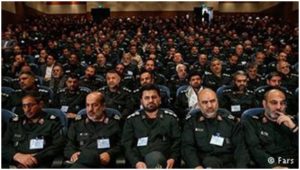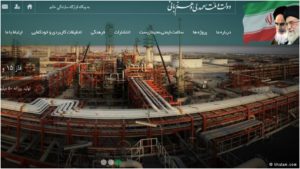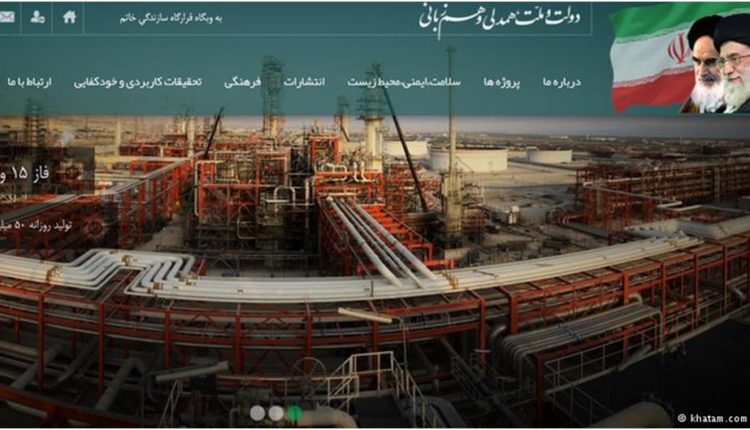Iran’s Economic Puppeteers
February 17, 2016
http://www.dw.com/en/irans-economic-puppeteers/a-19055910
They may dress in clerical garb or call themselves the “Seals of the Prophet,” but their focus is on a different kind of profit. Religious foundations and the Revolutionary Guard are running Iran’s business.

Every traveler that lands in Tehran becomes a customer of Iran’s Revolutionary Guard. That’s because the elite troops of the Islamic republic operate the Imam Khomeini International Airport, making extremely lucrative business through entry and landing fees alone. With control of the country’s other air and seaports, the Revolutionary Guard – also known the “Sepah Pasdaran” – monopolizes Iran’s borders. They pay neither tolls nor taxes. They choose which goods to allow into the country. And they aren’t questioned as to how many of these goods end up in the black market – or how much they have pocketed from them.
Businessmen in uniform
The Revolutionary Guard possesses land, sea and air forces, controls Iran’s strategic weapons arsenal, and numbers more than an estimated 120,000 troops. It also runs a gigantic commercial enterprise. It operates eye clinics. It builds dams, vehicles, highways, train tracks and even subways. It is closely intertwined with the country’s oil and gas business. It has its hand in mining.
Its activities are hard to fully grasp, and are therefore not often reported on by media outlets in the West. The BBC offered a rare look in 2009, covering the Revolutionary Guards’ $8-billion (7.2-billion-euro) deal to connect Iran’s southeastern port Chabahar to the country’s rail network. Less than 100 kilometers (62 miles) separate the deep-sea port on the Gulf of Oman from Iran’s border with Pakistan. Resource-rich Afghanistan is only a day’s trip away.

In charge of this strategic infrastructure project – as well as many other billion-dollar investments – was Khatam-al-Anbia, which translates to “Seals of the Prophets.” But no charitable goal hides behind the pious name – it’s the Revolutionary Guard’s engineering holding firm. Established at the end of the 1980s as the country sought to rebuild itself in the wake of its long war with Iraq, the firm carved out massive economic influence during the presidency of Mahmoud Ahmadinejad.
By now, the Pasdaran is believed to control up to a third of the national economy, an estimate that Iran expert Bahman Nirumand sees as realistic. “There are of course no precise statistics or data on this, but that is a prevalent estimate, that a third – maybe even more – of the Iranian economy is in the hands of the Revolutionary Guard,” he told DW. According to World Bank figures, Iran’s economic output in 2014 amounted to more than $425 billion. This would put the Pasdaran’s dealings at a volume of around $140 billion.

Businessmen in cleric’s clothing
But the strings of Iran’s economy are not pulled only by the military. Religious foundations led directly by the country’s highest Shi’ite clerics wield even far more influence. Germany’s Federal Foreign Office estimates that such companies command altogether up to 80 percent of Iran’s economy.
Nobody knows the full extent of their business dealings. They are not required to disclose their earnings and have never been held publically accountable. Many Iranians asked where billions of dollars disappeared to while Ahmadinejad was in power. But they received no answer. Bahman Nirumand recalled that corruption existed under the former rule of Iran’s shah as well, “but there weren’t pickpockets then in comparison to those wielding power today.”
“Setad” – otherwise known as the “Executive Headquarters of Imam’s Directive” – is one such religious foundation, worth now over $90 billion. According to a Reuters investigation, Setad was created shortly before the death of Ayatollah Ruhollah Khomeini, the first Supreme Leader of the Islamic Republic of Iran. He originally used it as a kind of clearinghouse for the former property of emigrated or dispossessed loyalists of the ousted Shah, redirecting it to the poor and needy. Since then, Setad has been rebuilt as one of Iran’s most influential companies, while remaining directly under the Supreme Leader.
Who profits from the lifting of sanctions?
Controlled by Ayatollah Ali Khamenei since 1989, the Setad empire, according to Reuters, stretches from the finance, oil and telecommunication sectors all the way to birth-control production and ostrich farming. Many Setad subsidiaries appeared on the most recent list of US sanctions, in an attempt to strike directly at the economic interests of the Iranian leadership. In the words of the US Treasury, Setad is not a harmless foundation, but a “major network of front companies” that is “controlled by Iran’s leadership” to “generate and control massive, off-the-books investments, shielded from the view of the Iranian people and international regulators.”
The lifting of sanctions by the West will therefore benefit these billion-dollar companies most. Expert Bahman Nirumand is at least hopeful though that the rest of Iran’s coffers won’t run completely dry: “The average person will also get something out of it, because trade will likely be building up more momentum. And that way the traders and the bazaaris and all those who offer services in Iran will profit from the end of the sanctions.”


Comments are closed.